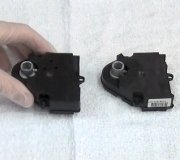When it's a noise that only occurs when the car is moving, you'll have to listen outsde while running alongside the car! OR, ... A much better idea is to use a tool called a "chassis ear". This is a set of six microphones that are clipped to various suspect parts under the car, then you switch between them while driving and listening with headphones.
When the noise occurs, you identify the loudest microphone, then move them around until you find the source of the noise. This is especially useful for clunks and rattles, but it works with almost any sound that you can hear.
This tool comes in two versions. The older style has six microphones with wires that must be carefully strung through a window or door and you have to be careful to route the wires away from tires and other moving or hot parts. The newer version has four wireless microphones and two still with wires. Many mechanics have never heard of this tool. Some shops have them. Some mechanics have their own.
Chrysler dealers have this tool. They also have one available that detects vibration. The souce of vibration is determined by comparing the frequency of the vibration to vehicle speed. Other dealers might have this tool too, although most dealership merchanics are experienced in finding these types of problems without special equipment.
Based on your followup descriptions, I would still be looking at engine mounts. There are two things that could happen when under reverse load, (down shifting). The engine could shift position slightly and cause the rollers in the inner cv joints to run in different locations in the housings. Worn spots can develop on the roller surfaces that cause the rollers to bind when the shaft is changing length or angle. More commonly that is felt in the steering wheel when turning sharply and accelerating normally from low speeds, but it depends on a number of conditions. The binding rollers could cause the engine to be pushed back and forth sideways once or three times per tire revolution. This is a very low speed pulsation that will not make an audible sound, but you could be hearing the RESULTS of the engine moving. That could be a pulley rubbing on a plastic splash shield, an exhaust pipe hanger touching metal on metal, or any other source where two pieces come in contact with each other to transmit sound.
A simlar condition can exist when the engine rocks forward and backward. Most font-wheel-drive engines with manual transmissions have a damper to limit the amount of engine movement caused by the constant on / off rocking during shifting. If that damper is worn or broken, the engine will oscillate back and forth. Besides the obvious parts touching each other, a gap could open up in the flexible exhaust pipe coupler, or a loose part in the air intake system could open a gap that prevents the system from muffling the turbulence of the incoming air.
The chassis ear does not work well for these kinds of noises that must be "heard". The microphones work best when the noise is transmitted through a part the microphone can be physically attached to.
Caradiodoc
Thursday, March 25th, 2010 AT 2:36 PM




